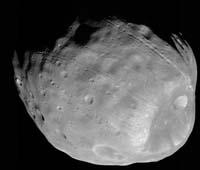Fobos could be formed by rocks detached from the Martian surface

Data recently collected by the Mars Express probe can help clarify the origin of the Mars Phobos moon. Members of the European Space Agency (ESA) claim to have obtained "clarifying evidence" to believe that Fobos is formed by rocks released from the surface of Mars in a massive explosion.
The data were presented at the European Congress of Planetary Science in Rome. And there, researchers have defended two fundamental hypotheses. According to the theory that has taken more force, Mars collided with a spatial rock, which caused the accumulation of materials detached from the surface of the planet and the formation of the moon Fobos. The other theory says that Fobos was formed with the remains of an older moon, broken by the gravity force of Mars.
Following previous studies, many astronomers believed, for example, that the two moons of Mars could be two asteroids trapped by gravity when Mars was formed: Fobos and Deidos. Now, however, the discoveries of the ESA have distorted this hypothesis, since they have assumed that there was a strong shock at the origin of Fobos.
The most illustrative data to reach this conclusion is related to a mineral. In fact, a phyllosilicate was first detected on the surface of Fobos, especially in the north-eastern areas of the crater called Stickney. These physilicate rocks, supposedly arising from the presence of water, have been discovered on Mars.
Buletina
Bidali zure helbide elektronikoa eta jaso asteroko buletina zure sarrera-ontzian











